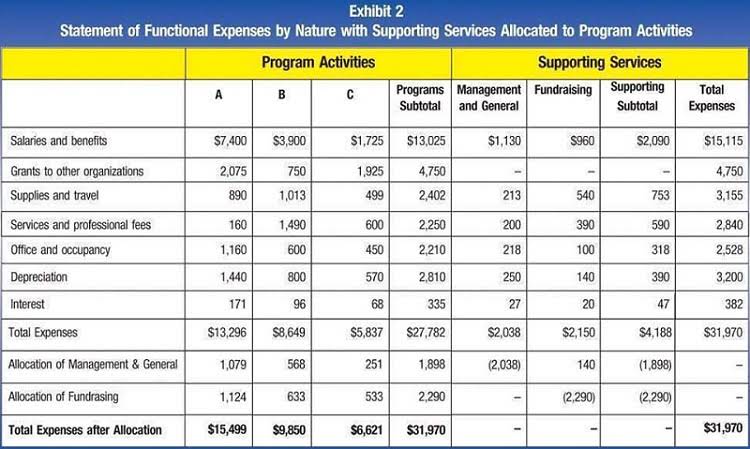Content

The more precise accrual accounting method has you record transactions when you earn revenue and incur expenses, not necessarily when cash flows. All accrued expenses are liabilities on your balance sheet until they’re paid. Luckily, payroll software automates most manual labor and decreases the chance of human error. Just set the software to automatically reverse accrued payroll entries when the next pay period comes, and you’re good to go. A fiscal period can refer to a calendar month, quarter, or
year, depending on how often the company prepares financial statements. While
larger companies may want to accrue for payroll expenses monthly, mid- or
small-size companies may want to do that quarterly or annually.
- As I mentioned, I don’t owe FUTA and SUTA on Susie’s wages since I’m accruing payroll at the end of the year, after she’s earned more than $7,000 for the year.
- He’s paid once a month (payday comes on the last workday of the month) and works 40 hours per week, five days a week.
- Therefore, as of June 30 the company owes its hourly-paid employees for the amounts they earned between June 22 and June 30.
- For small businesses that use the accrual method for accounting, it’s important to record your expenses in the month they’re incurred, even if you pay for them later.
- Due to accrual accounting, company owners can record customer payments made by check or credit card as money.
- You may also hear it referred to as accrued payroll or salary accrual.
- Once you’ve calculated overtime pay, you can add this to the sum of what you owe your employee.
We’ll use the previous example of $818.28 in payroll payable to see how this amount works through your general ledger using journal entries. There is a “cap” in terms of the duration in which a compensation-related payment can be delayed, unlike delayed payments to suppliers or vendors. But, if you are hiring contractors, you’re probably spending too much time on their payroll, contracts, and tax documents. Which is why we built Panther, which saves you 90% the time you spend on contractor paperwork each month.
Example Holiday Accrual Calculation by Days
If you forget to reverse accrued payroll entries, they’ll be counted again in the next pay period. This can cause payroll errors, which could feed into your income statements, balance sheets, and reported cash flow. Depending on the length of the payroll cycle, it is less common to have any accrued payroll for salaried employees, since they are frequently paid through the end of the accounting period. The largest source of accrued payroll is likely to come from salary and wages payable to employees. These are wages that are owed for the labor performed by your employees and are accounted as a liability until payday, when they become an expense. However, it’s a good idea to understand the size of your liabilities as a business owner.

It is simpler than the accrual method but shows a lagging, incomplete picture of the company’s financial standing. The payroll accrual is the amounts a company owes for work done by employees, but the amounts have not yet been recorded in the company’s general ledger accounts. Within QuickBooks, you can prepare a single journal entry to record all salaries. Save the entry, then press “Reverse” to create a reversing entry on the first day of the present month. This will ensure your accrued payroll is reported in the appropriate period. Keeping track of payroll entries, credits, and debits for every employee in your organization as well as the many other expenses you face leaves room for error.
Easy Process
It is critical that you understand what increases or decreases the accrued payroll on the balance sheet. Accrued payroll would increase for compensation that has been earned but is unpaid. Accrued payroll would then decrease when the compensation is paid in cash/check to the employee. I’m sure you have wondered why there is a lag between when you “work 2 weeks” and when you actually receive your paycheck right? Under the accrual method, compensation expense must be recognized when it is earned by an employee and not when it is paid.

According to Acas, all employees have the right to paid holiday regardless of whether or not they’re full-time, part-time or following a zero-hours contract. Are you a business owner or manager wondering what in the world “accrued payroll” means? In this post, we’ll break down what accrued payroll is, why it’s important, and how to calculate it. Dancing Numbers is SaaS-based software that is easy to integrate with any QuickBooks account. With the help of this software, you can import, export, as well as erase lists and transactions from the Company files. Also, you can simplify and automate the process using Dancing Numbers which will help in saving time and increasing efficiency and productivity.
Account for your employee’s earned PTO entitlement
After that, apply the filters, select the fields, and then do the export. The Ascent is a Motley Fool service that rates and reviews essential products for your everyday money matters. We’re firm believers in the Golden Rule, which is why editorial opinions are ours alone and have not been previously reviewed, approved, or endorsed by included advertisers. Editorial content from The Ascent is separate from The Motley Fool editorial content and is created by a different analyst team. If you’re using the wrong credit or debit card, it could be costing you serious money. Our experts love this top pick, which features a 0% intro APR until 2024, an insane cash back rate of up to 5%, and all somehow for no annual fee.
How do you accrue payroll at year end?
How to Calculate Accrued Payroll. The amount of accrued payroll to record at the end of an accounting period is usually comprised of the compensation owed to hourly employees for the period from the last day paid through the end of the period, plus any payroll taxes related to those unpaid wages.
Since you haven’t paid for those days yet, you can’t count them as a payroll expense. Instead, you’ll record them as accrued payroll to show that you owe that money. The intuition is that an increase in accrued wage leads to more short-term liquidity because the owed cash payment to employees is retained by the company. The use of accrued payroll accruals for biweekly payroll is a standard accounting practice. The goal of this guide is to explain the biweekly payroll accrual process in greater detail, including how to identify biweekly payroll accrual transactions within financial reports. Add the sum that you pay toward your employee’s health insurance premiums next.
How to Calculate Accrued Payroll?
On the other hand, a decline in the accrued wages balance occurs when the company fulfills the payment obligation to their employees (and results in less cash on hand). Holiday pay accrual is the amount of holiday time that an employee has left over at the end of a 12-month period that has not been used or paid. An employee is entitled by law to payment for this unused holiday time, although you can decide how this is compensated, whether through payment or by honouring this holiday time at a later date.
These payroll expenses will now be recognized in January, the month they actually occurred. An accrued payroll journal entry represents each written account of a transaction related to payroll accrual. Cash accounting is a form of accounting in which transactions only get recorded upon cash coming in or out.
Be careful you just tally up the hours that they worked without receiving compensation. In this manner, both they and you are aware of the pay period for which you should compute their salary. Furthermore, you should be aware that most states have a necessary pay frequency. The withholding amounts and payroll tax charges are your duty as the employer. Payroll taxes must be recorded if you want to keep up with IRS regulations.
- On the other hand, a decline in the accrued wages balance occurs when the company fulfills the payment obligation to their employees (and results in less cash on hand).
- First is the employee-paid taxes, which come out of your employee’s paycheck.
- If you forget to reverse accrued payroll entries, they’ll be counted again in the next pay period.
- Editorial content from The Ascent is separate from The Motley Fool editorial content and is created by a different analyst team.
- With every month they work for you, your employees earn a certain amount of paid time off, for example 2 days for each month worked.
- Overtime usually needs to be compensated with a wage supplement, which is why pay for additional hours needs to be calculated separately.
In contrast, updating a general ledger in cash accounting only accounts for money that has entered or exited. To calculate taxes and contributions, you can look at a similar payroll period or run the numbers through an online payroll calculator. Accrued payroll shows the amount of money due for employees and independent contractors, which helps decision-makers set the course of action regarding company spending. For salaried employees, calculate their daily rate and then multiply it by the number of days they’ve worked but haven’t been paid for yet. The monetary benefit related to the productivity of the employees was already received—i.e. The employees have delivered their services to the company as part of their employment agreement—so, the expense must be recognized in the month of December.
Cash to accrual for inventory and cost of goods sold?
The first time I heard anyone use the accounting terms “accrue” and “accrual”, I must admit I was a bit intimidated. More importantly, by taking the concept of accrual into account, you can produce a monthly Profit and Loss Statement that is infinitely more accurate, especially as it relates to your payroll costs. Accrued payroll is an accounting method that tracks debts (or accrued liabilities). Instead of tracking expenses once you’ve processed them, accrued payroll includes expenses or debits that are still pending.
- After payroll deductions for taxes, retirement payments, and other garnishments are made, employees get their net pay.
- Then, when the compensation is paid, the company would debit accrued payroll to remove the liability and credit cash for the cash outflow related to paying the employees compensation.
- This is because your company still owes the employee the value of their PTO even if they don’t take time off in that specific month.
- Keeping up with a journal entry for every employee can be challenging, which is why many employers have begun opting for automated payroll management solutions.
- In this post, we’ll break down what accrued payroll is, why it’s important, and how to calculate it.
Holiday accrual refers to any paid holiday time accumulated, regardless of whether it’s been used or not. Now that you know what accrued payroll is, it’s time to start tracking it. You can use a spreadsheet or accounting software to keep track of your employees’ hours, pay rates, and deductions. You’ll also want to make sure that you have a system in place for paying your employees on time, such as direct deposit or paper checks. Our all-in-one platform makes international payroll faster and easier, we also help ensure that you are in compliance with local labor laws.
Payroll taxes, deductions, and contributions
Finally, remember to include the whole amount of paid time off (PTO) you provide to your staff in your accumulated payroll expenses. PTO that hasn’t been utilized yet still counts since you’re using accumulated payroll rather than the payment that has already been paid out. Since you still owe your employee this money, it still counts as an accumulated liability in your company’s books. Social security contribution rates vary from country to country, but mostly include premiums for health, long-term care, unemployment, accident and pension insurance of some sort. Calculate your employer contribution to each of these insurances as well as what you owe in employer payroll taxes. Again, add the calculated amounts to the gross wages, bonuses and overtime pay.
Is accrued payroll on the balance sheet?
Accrued Wages Definition in Accounting
The accounting term “accrued wages” describes the unpaid compensation not yet paid by a company to employees for the services they have already provided. Accrued wages are categorized under the accrued expenses line item, which is a current liability on the balance sheet.

